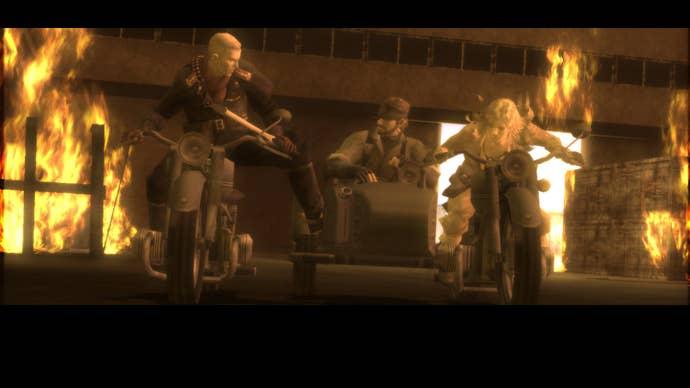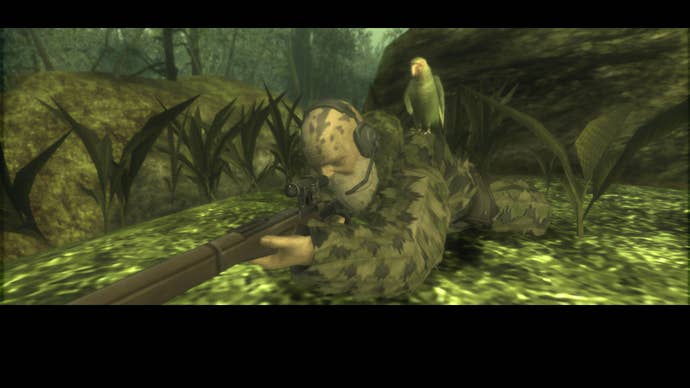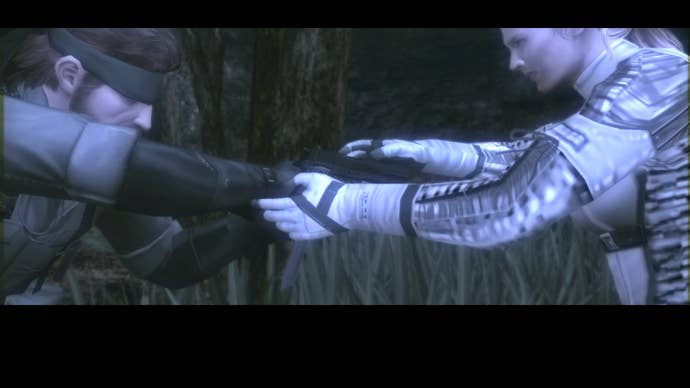Five Reasons Why Metal Gear Solid Will Never Top Snake Eater
10 years after its release, Hideo Kojima's unexpected foray into the '60s remains his series' finest hour.
This article first appeared on USgamer, a partner publication of VG247. Some content, such as this article, has been migrated to VG247 for posterity after USgamer's closure - but it has not been edited or further vetted by the VG247 team.
Metal Gear Solid 3: Snake Eater exists as the byproduct of a singular event that isn't likely to happen again: The humbling of Konami's Hideo Kojima.
Whether you like it or not, there's no denying Metal Gear Solid 2: Sons of Liberty stands as one of the most polarizing games ever. For those who couldn't jive with its twists, turns, and protagonist bait-and-switch, MGS2 spelled the end of Kojima's career—or, at least, indicated his series had finally jumped over the shark and into oblivion. One of the most anticipated games of all time quickly became the Internet's punching bag, and, three years later, Metal Gear Solid 3 acted as a direct response to this phenomenon: It actively washes its hands of (and often directly mocks) Sons of Liberty's antics, and instead pulls the series back to its roots with a focus on the man who would eventually become the 8-bit antagonist, Big Boss.

With Snake Eater, Kojima had to prove his relevancy to the gaming public, and while many abandoned ship after MGS2's befuddling ending, those who stayed on board were treated to a stunning example of how Metal Gear's creator hadn't lost his touch. 10 years have passed, and Snake Eater still holds the honor of being the series' highlight—at least in this writer's eyes. Read on to discover the many ways Metal Gear Solid 3 outshines its fellow sequels, despite its complete lack of mysteries rooted in nanomachines.
Note to the concerned: If you haven't finished MGS3, thar be spoilers ahead, matey.
It Trades William Gibson for Ian Fleming
The high-minded philosophizing and speculative fiction of Sons of Liberty gave it a distinct personality, but by the end, it lost much of its humanity in the unrelenting waves of technobabble—Kojima was trying to alienate the player, after all. Snake Eater abandons this self-serious tone for something much more approachable: the campy world of '60s James Bond cinema. MGS3 isn't without its moments of pathos and tear-choked monologues, but its roots in the (fictionalized) past gives it a sense of tangibility the previous game lacked. And this backdrop forced the Metal Gear team to show some restraint in regard to Snake's collection of gadgets and gizmos, which, for the most part, aren't far removed from the era. Even if you enjoyed Sons of Liberty, you have to admit the beginning of Snake Eater really smashed through any sense of pretension with its amazing, Bond-inspired theme song. When the Shirley Bassey-esque chanteuse belts out, "One day, you'll feed on a tree frog," you know you're in for a game that doesn't take itself too seriously.
Naked Snake > Solid Snake
At this point in time, Naked Snake (Or is that Venom Snake?) is undeniably the star of Metal Gear Solid, but back in 2004, that simply wasn't the case. Had Kojima known this series would stretch on for so many sequels, he probably wouldn't have had Snake essentially go through his entire character arc in the original Metal Gear Solid, because, after this game, there wasn't much left for him to do. So Snake Eater turned back the clock for a look at the roots of Metal Gear's Big Boss, an improbably named character who served as the antagonist for the first two games of the series.
Despite all of ways this could have went wrong, Metal Gear Solid 3 develops this former 8-bit big bad into a compelling character who acts as more than a conduit through which players receive exposition. From his beginnings in Snake Eater through Peace Walker and the upcoming Phantom Pain, we witness how the transformation of the solider from a nationalist role to a capitalist one gradually warps Naked Snake into a slightly misguided but sympathetic character who's simply looking for a purpose in life. Sure, he's still prone to shouting out, "Metal Gear!?" but with so many of those damn things stomping around, who wouldn't be?

A Wealth of Stealth (Options)
Going from the cramped confines of Metal Gear Solid 2's aircraft carrier and oil refinery to the wide-open jungles of the Soviet Union really opened up the possibilities for stealth in Snake Eater. MGS3 gives Snake a variety of camo and facepaint options, and while equipping them might require a little too much futzing around in menus, disguising yourself appropriately can really give you an advantage over the patrolling soldiers.
Snake Eater provides more than just additional ways to hide, though: You can poison guards with spoiled food, distract them with naughty magazines, stick a knife to their throats for the sake of interrogation, disguise yourself as a crocodile to send foes running, and even blow up the enemy's food supply to fill the area with starving, inattentive soldiers. And the environments themselves offer inventive new ways to dispatch enemies, like sending active hornet nests crashing down on their skulls. Of course, Snake Eater encourages pacifism, and if you know what you're doing, the only thing you'll leave behind in any area will be a dogpile of peacefully sleeping guards.
Unforgettable Boss Fights
Even if you don't think Snake Eater stands as the height of the Metal Gear Solid series, you at least have to admit it contains the most inspired and engaging boss fights. And no discussion of MGS3 would be complete without a mention of the battle against The End, a boss fight tasks Snake with tracking down and eliminating an opponent using all of his tools—and one that can last hours if you're not lucky. And the other bosses aren't slouches, either, with each one possessing a unique gimmick that makes fighting them an absolute blast. From the hornet-shooting madman (a concept slightly presaged by The Simpsons) The Pain to the flamethrower-wielding former astronaut, The Fury, bosses don't get much more creative than what you'll find in Snake Eater... which is probably why MGS4's only amounted to a quartet of supermodels who simply riffed on characters we saw in the first Solid.

The Boss: One of Gaming's Greatest Characters
At this point, it's more than clear Hideo Kojima isn't the greatest at treating his female characters with respect—just take a look at MGSV's bikini-clad sniper and vagina bomb if you need some stunning examples. Snake Eater, on the other hand, features one of the best female characters in gaming with The Boss, Naked Snake's capable and mature mentor. In fact, it could be said that the entirety of Metal Gear Solid revolves around this character, as her untimely and tragic death serves as the impetus for the rest of the series.
Yes, you can claim it's a distinctly anti-feminist move to have this strong female character die to give the male lead a purpose—and I wouldn't necessarily disagree—but, in this medium, we takes what we gets. Naked Snake's slightly Oedipal relationship with The Boss gives a great deal of heart to the often-cartoony spy antics of Snake Eater, so much so that it'd be hard to imagine this installment being so impactful without her. And even though having to off her yourself provides one of the most harrowing button-presses in all of gaming, the battle leading up to the moment ranks up there with Journey and Shadow of the Colossus in terms of unbridled, bittersweet beauty. Metal Gears may come and go, but outdoing the magic of Snake Eater would take nothing short of a miracle.
